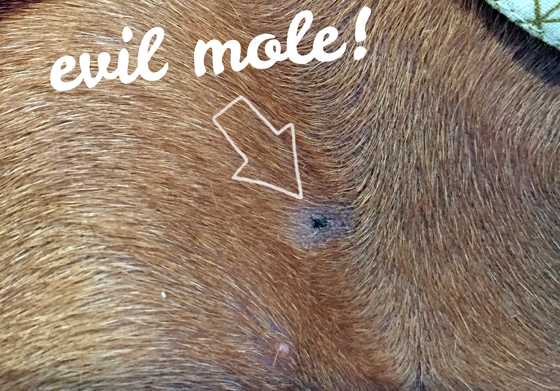
Moles may be present at birth or gradually appear later in the newborn period. Molehills consist of pure loose soil.

Based on conservation estimates the mole family as a whole appears to be a picture of excellent health.
What do dog moles consist of. Moles on dogs are common especially on dogs with darker pigment in their skin. The scientific name for moles on dogs is sebaceous adenomas. They can appear anywhere on the body much like skin tags.
They differ from skin tags in structure and texture. Skin tags tend to be small and floppy but moles are flatter and harder. Moles on dogs may be benign or malignant and develop due to an abnormal division and multiplication of the cells.
The division and multiplication of cells is controlled by the genes in the nucleus of cells. However there may be some external factors that could influence the abnormal growth of skin cells. Appearance of Canine Cancerous Moles.
A moles diet primarily consists of earthworms and other small invertebrates found in the soil. The mole runs are in reality worm traps the mole sensing when a worm falls into the tunnel and quickly running along to kill and eat it. The sweet taste buds in dogs respond to a chemical called furaneol which is found in many fruits and in tomatoes.
It appears that dogs do like this flavor and it probably evolved because in a natural environment dogs frequently supplement their diet of small animals with whatever fruits happen to be available. Various species of moles can cause damage to yards gardens and pastures with their tunneling. These mammals dig through soil in search of a variety of food sources like insects small arthropods and earthworms.
In addition to regularly snacking on the adult stages of insects moles enjoy feasting on grubs. Moles have a wide distribution around the globe except in South America and Antarctica. These small mammals spend most of their time underground.
Moles dig the ground to find their food which mostly constitutes of earthworms. They also eat a wide array of small invertebrates and at times nuts. Most mole problems consist of one or two moles doing a considerable amount of damage.
A good indication of how many moles you may have is to clear all the hills away with a rake. You can then determine how many areas are active concurrently by observing where the new mole hills are being created. Moles are not known to known to be dangerous to pets or even human beings.
Moles resemble rats and at some point will behave like they are rats that are found in the homes. However you can easily tell moles from rats by their bad smell and their slowness moles do not walk as fast as rat do. They also have a unique velvety gray fur.
Moles also eat larvae small plants grass roots bulbs seeds vegetable crops and their roots. The diet of a mole also consists of centipedes crickets millipedes beetles snails termites grubs sow bugs and ants. They constantly search for.
The moles only come together for the purpose of mating purposes and after that they live solitary lives. The males do not participate in raising the young ones. Moles are not social animals and will not live together for long they will be together usually during mating which could last a few hours.
Mole rat female leaders are often referred to as the mole-rat queens and they lead entire colonies that can be made up of up to 300 members. The queens are dominant when searching for their sexual partners as well. They pick the strongest and largest males and mate with them multiple times per year.
Moles are carnivores feeding almost exclusively small invertebrate animals living underground such as earthworms and the larvae of beetles and flies. A mole may also occasionally catch small mice at the entrance to its burrow. Moles are the bane of many homeowners who spend hours perfecting their yards.
Moles leave large garish piles of dirt on top of sod burrowing through the layers of soils in search of insects and grubs. Moles can also be very difficult to trap because of their time spent underground and their tendency to abandon tunnels after one use. One solitary moles range can extend up to 27 acres.
A moles underground territory consists of large complex burrow systems with separate areas for living and for hunting. Moles are insectivores eating 70-100 of their weight in worms grubs and insects each day. Moles occur in all races Caucasian Asian African and Indian and skin colors.
Even animals have moles. Do babies get moles. Moles may be present at birth or gradually appear later in the newborn period.
Many children continue to develop moles through the teenage years and into young adulthood. Moles live on average two to three years but have been known to live up to six. Deaths are caused mainly by persecution from humans although cats dogs stoats and predatory birds will take moles when above ground and some are killed by traffic.
Typically between 13 and 16 cm in length moles have. Based on conservation estimates the mole family as a whole appears to be a picture of excellent health. According to the IUCN Red List which tracks the conservation status of numerous species these creatures are mostly listed as being of least concernHowever there are several exceptions including the Etigo mole of Japan and the.
Molehills consist of pure loose soil. When moles dig they push the loosened soil up a shaft to the surface forming piles of earth. These molehills are easy to spot and indicate the presence of moles.
Moles use molehills as a food source especially for earthworms and insects. The location of moles is greatly related to peoples fortune. Moles consist of obvious and hidden ones.
The moles on face are easily seen and regarded as the obvious while those on other parts of the body are called the hidden. Generally the hidden moles such as in the eyebrows beard hair etc are auspicious and the obvious are. Yards infested with vermin like moles may have dogs digging like crazy to find what they can hear and smell.
There are other practical reasons for. Interramal whiskers grow from a mole under a dogs chin. These moles contain clusters of cells that provide sensory and tactile information to the brain.
They are incredibly useful in detecting food water and other objects that are out of the normal field of vision.